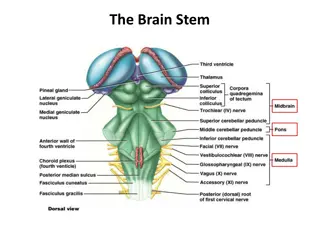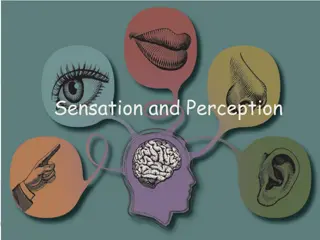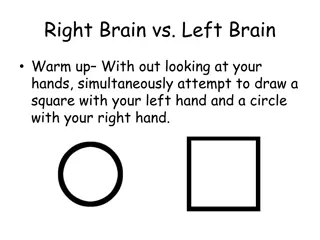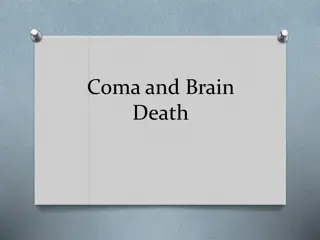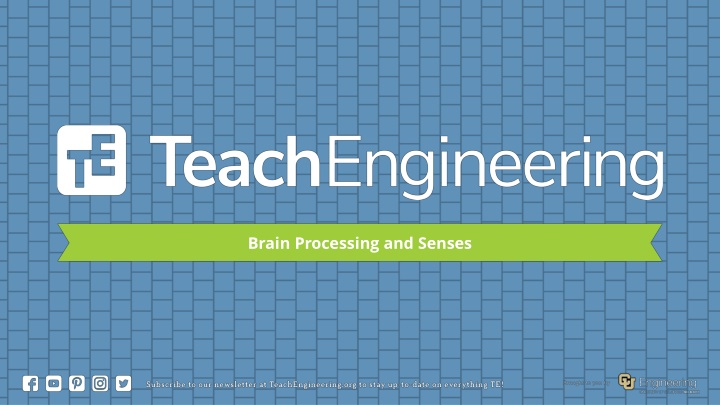
Sensory Processing in Animals and Humans
Explore the similarities and differences in how animals and humans detect and process sensory information. Dive into topics such as reaction time experiments, analyzing data terms, and the role of senses in survival. Engage in hands-on activities to learn more about brain processing and senses.
Download Presentation

Please find below an Image/Link to download the presentation.
The content on the website is provided AS IS for your information and personal use only. It may not be sold, licensed, or shared on other websites without obtaining consent from the author. If you encounter any issues during the download, it is possible that the publisher has removed the file from their server.
You are allowed to download the files provided on this website for personal or commercial use, subject to the condition that they are used lawfully. All files are the property of their respective owners.
The content on the website is provided AS IS for your information and personal use only. It may not be sold, licensed, or shared on other websites without obtaining consent from the author.
E N D
Presentation Transcript
INTRODUCTION Do all animals have the same senses? Do humans use their senses for the same reasons animals do? Do you think all animals bodies process sensory information the same way? How do animals and humans detect, process, and use information about the environment? Do you know the system that animals use to process sensory information in their brains? What are some of the ways animals' senses are the same as or different from humans? You use your senses every day and you might not even be aware of it.
INTRODUCTION (CONT) Has anyone here ever caught a ball? Think about the steps involved in catching a ball. What is the first step? What s the next step? Next step? You react. The last step? Your body performs the task your brain told it to do, and you caught the ball. What is "reaction time," and how does it help an animal survive? What is an instinct?
REACTION TIME EXPERIMENT Make sure everyone has a partner. Watch this video to show you an example. Supplies each partnership needs: o ruler o pencil o Brain Processing and Senses Worksheet o calculator (optional) o Make a prediction on what you think your fastest time will be, as well as your slowest time, and record them on your worksheet.
10 TRIALS Each person will need to complete 10 ruler drop trials and record them on the worksheet in centimeters. If you fail to catch the ruler, redo the drop until you catch it. After completing all 10 trials, use the reaction time chart to find the distance for each trial and then write down the reaction time that correlates in seconds next to it. Look at your reaction times over your 10 trials and analyze the changes, if any, across them.
ANALYZING DATA TERMS Mean ( Average ): Add up all the numbers and then divide by how many numbers there are. Median ( Middle Number ): Order numbers from lowest to highest. Identify the middle number, or the average of the two middle numbers. Range ( Highest Minus Lowest ): Subtract the lowest value from the highest value. Mode ( Most Often ): Identify the number that occurs the most often. (There might be more than one.) Outlier ( Out There ): A value in a set that is very far away from the other values. (There might not be one.)
MEAN Mean: Write each reaction time on a line below.
MEDIAN Median: Write the reaction times from lowest to highest. If the number in the ( ) is the same, then that is your median, if the numbers are different, add them up and divide by 2.
RANGE Range: Write the highest reaction time first and the lowest reaction time second. Then subtract them to find the range.
MODE Mode: Write the number(s) that come up the most times. If each number only comes up once, you won t have a mode.
OUTLIER Outlier: Write the number that is very far away from the other values. You might not have one.
CLASS DATA Everyone is going to give their mean one at a time, and then the class is going to create a line plot with the data. Your mean should be between 0.05 and 0.25 seconds. If it isn t, then you need to recalculate it.
CLASS MEAN Class Mean: Add up all the students means and divide by how many students there are to find the class mean.
CLASS MEDIAN Class Median: Use the Class Reaction Time Line Plot to help you find the mean. Start by putting a dot next to the lowest number X and then one next to the highest number X. Continue this until you have one number left, or two different numbers. If you have one number left, that is your class median. If you have two numbers left, add them up and divide by 2 to find the class median.
CLASS RANGE Class Range: Write the highest reaction time first and the lowest reaction time second. Then subtract them to find the range.
CLASS MODE Class Mode: Write the number(s) that come up the most times. If each number only comes up once, you won t have a mode.
CLASS OUTLIER Class Outlier: Write the number that is very far away from the other values. You might not have one.
AFTER EXPERIMENT Were your predictions true for your fastest and slowest times? Explain. Are there differences between any of your trial times? Why do we perform the experiment more than once? If your time decreased meaning it took you less time to catch the ruler what does that mean? Why was the ruler caught in the middle (after a lag period) rather than at the end (instantaneously)? What causes this delay? What had to happen in your body for you to catch the ruler? How can your reaction time be improved?
VIDEOS Watch one or more of these videos: BrainPop Nervous System- https://www.brainpop.com/health/bodysystems/nervouss ystem/movie Generation Genius Brain Processing of Senses https://www.generationgenius.com/videolessons/senses- video-for-kids A Journey Through Your Nervous System https://www.youtube.com/watch?v=VAEmxt78bBI
GROUP DISCUSSION Get in groups of four. Discuss what was taking place in your bodies as you tried to catch the ruler. Create an explanation on your worksheet with your group. You may use words, drawings, or a combination of both. Each group will share their thoughts with the whole class to create a class explanation about how their bodies and brains worked together to catch the ruler.
GROUP BRAINSTORM Get in a new group of four. Brainstorm some common actions you do in your lives that are triggered by information coming in from your senses. Name at least 10 different actions and identify the sense or senses that received the information. Beside each action and its senses, list how that action helps with survival in the classroom, at home, on the playground, and other places you spend time. Write this down on the worksheet.
3D MODEL With a new group of 4, you are going to create a 3D model showing how the sensory network is involved in receiving, transmitting, and responding to input from senses. Sketch a diagraph of the 3D model you plan to build. You will need to label the model with the following words: information, receptors, perception/memory, and action. Possible items you can use to build: electronics exploration kit, magnetic building sticks, Legos, wood building planks, building blocks, interlocking disks, building set, Play-Doh. Your diagram will need to be approved before you can start building.
VIDEOS Watch one or more of the videos about brain protection: BrainPop https://www.brainpop.com/health/diseasesinjuriesan dconditions/concussions/movie Mystery Science Mini Lesson https://mysteryscience.com/mini-lessons/football- helmets Protect your Brain https://www.youtube.com/watch?v=nYR2j9oQGPs
PROTECTING THE BRAIN Why? Your brain is in charge of your body and controls everything that you do. When? We should protect our brain whenever riding a bicycle, in-line skating, skateboarding, or playing contact sports. Where? Outside or in sports situations. Who? Everyone! How? By wearing a helmet!
ASK What is the problem? The brain needs protecting from head injuries (wrecks, hits, falls, etc.) What do we want to design? A helmet to protect the brain (egg) Who is it for? Students (egg) What do we want to accomplish? Protect the brain from injury
ASK What are the project requirements and limitations? Limitations Two to three class periods Supplies given Requirements The egg (brain) must not crack when dropped from different heights up to 5 feet. What is our goal? Create a helmet to protect the egg (brain) from cracking using the supplies given and within three class periods.
RESEARCH These resource are available for research if needed: https://www.youtube.com/watch?v=4nvhVv5uNI0 https://www.healthychildren.org/English/safety-prevention/at-play/Pages/bicycle- helmets-what-every-parent-should-know.aspx https://helmets.org/howmade.htm https://www.cdc.gov/heads- up/media/pdfs/helmets/headsup_helmetfactsheet_bike_508.pdf?CDC_AAref_Val=ht tps://www.cdc.gov/headsup/pdfs/helmets/headsup_helmetfactsheet_bike_508.pdf
IMAGINE Get in a group of 4. Bring your research together and write down as many ideas and solutions that your group might want to explore.
PLAN Must have majority of the group members agree on which solution you would like to move forward with. Make sure everyone in the groups gets suggest an option.
CREATE You may use any of these items to make your prototype: cardboard, egg cartons, pipe cleaners, rubber bands, straws, yarn, string, tape, newspaper, bubble wrap, cotton balls, sponges, pom poms, feathers, popsicle sticks, clay. If there are other things that you would like to make your prototype out of that aren t listed above, ask to see if it is possible.
TEST Try dropping your egg from different heights ranging from 1 foot to 5 feet. Write down your results and discuss with your team and analyze what works and what you need to improve.
IMPROVE As a group, discuss how you want to improve your prototype. Make revisions and continue to test until you have a final product.


